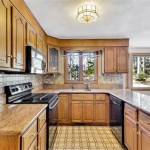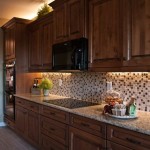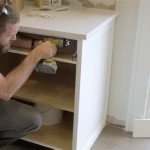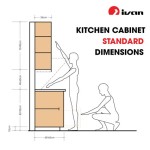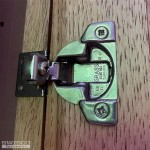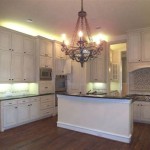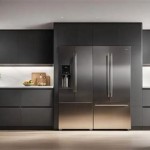Should I Reface Or Replace My Kitchen Cabinets?
The kitchen often serves as the central hub of a home, necessitating careful consideration when planning renovations. Among kitchen remodeling projects, updating cabinets constitutes a significant undertaking, impacting both aesthetics and functionality. Homeowners frequently face the decision of whether to reface or replace their existing kitchen cabinets. Both options present advantages and disadvantages, warranting a thorough evaluation of various factors to determine the most suitable approach.
Refacing cabinets involves replacing the existing doors, drawer fronts, and hardware while retaining the existing cabinet boxes. This option typically involves applying a new veneer to the exposed surfaces of the cabinet boxes to achieve a cohesive and updated appearance. Replacement, conversely, entails removing the entire existing cabinet structure and installing new cabinets in their place. This provides an opportunity to alter the kitchen layout, improve storage solutions, and select cabinets that align with current design trends.
The optimal choice between refacing and replacing cabinets hinges on several considerations, including budget constraints, the condition of the existing cabinet boxes, desired aesthetic changes, and the overall scope of the kitchen renovation project.
Cost Considerations: Refacing vs. Replacement
One of the most significant determining factors in the refacing-versus-replacement decision is cost. Generally, refacing cabinets is a less expensive option than replacing them entirely. The primary reason for this cost difference lies in the reduced labor and material requirements. Refacing utilizes the existing cabinet structure, eliminating the need for demolition and disposal of old cabinets and the purchase of entirely new units.
The cost of refacing typically includes the cost of new doors, drawer fronts, hardware (such as hinges and pulls), and the veneer or laminate used to cover the existing cabinet boxes. Labor costs will entail the removal of old hardware, the preparation of the existing surfaces, the application of the veneer, and the installation of the new doors and drawer fronts. The specific cost will vary based on the chosen materials, the complexity of the design, and the labor rates in the homeowner's geographic area.
Replacement, on the other hand, involves a significantly higher investment. The cost encompasses the purchase of new cabinets, which can range from stock models to semi-custom or custom-built options. Demolition and disposal of the existing cabinets also contribute to the overall expense. Furthermore, plumbing and electrical work may be necessary if the kitchen layout is being altered, adding to the total project cost. Labor costs for replacement include demolition, installation of the new cabinets, and potential modifications to plumbing and electrical systems.
Homeowners should obtain detailed quotes from multiple contractors for both refacing and replacement to accurately compare the cost implications. These quotes should clearly outline the scope of work, materials to be used, and associated labor charges. A thorough cost analysis will provide a solid foundation for making an informed decision.
Condition of Existing Cabinet Boxes: A Crucial Assessment
The structural integrity of the existing cabinet boxes plays a critical role in determining the viability of refacing. If the cabinet boxes are in good condition – meaning they are square, level, and free from significant damage such as water damage, warping, or rot – refacing becomes a more attractive option. However, if the cabinet boxes are damaged or structurally unsound, replacement is generally recommended.
Before considering refacing, a thorough inspection of the cabinet boxes is essential. Check for signs of water damage, particularly around the sink and dishwasher. Examine the corners of the cabinet boxes for signs of separation or weakness. Assess the stability of the shelves and ensure that they are securely attached. If any of these issues are present, refacing may not be a long-term solution, as it would simply mask underlying problems rather than addressing them.
Even if the cabinet boxes appear to be in relatively good condition, it is advisable to consult with a professional contractor to obtain an expert opinion. A contractor can identify potential issues that may not be readily apparent and provide guidance on whether refacing is a suitable option. In some cases, minor repairs to the cabinet boxes may be necessary before refacing can proceed. However, extensive damage will likely necessitate replacement.
Choosing to reface compromised cabinet boxes can lead to future problems and potentially costly repairs. A sound structural foundation is paramount for ensuring the longevity and functionality of the kitchen cabinets.
Aesthetic Goals and Design Flexibility: Shaping the Kitchen's Look
The desired aesthetic changes and the level of design flexibility required are significant factors in determining whether to reface or replace kitchen cabinets. Refacing offers a more limited range of design options compared to replacement. While new doors, drawer fronts, and hardware can significantly alter the appearance of the cabinets, the underlying cabinet structure remains the same.
Refacing allows for changes in door style, color, and material. Homeowners can choose from a wide variety of door styles, ranging from traditional raised-panel designs to contemporary flat-panel options. Colors can be customized to match the overall kitchen décor. Material choices include wood veneers, laminates, and solid wood options. New hardware, such as pulls and knobs, can further enhance the updated look.
However, refacing does not allow for changes to the cabinet layout or the addition of new storage solutions. If the homeowner desires to modify the kitchen's configuration – for example, by adding an island, increasing counter space, or incorporating specialized storage features – replacement is the more appropriate choice.
Replacement provides complete design flexibility. Homeowners can select cabinets in any style, color, and material. They can also choose from a wide range of cabinet configurations, including base cabinets, wall cabinets, pantry cabinets, and specialty cabinets. Moreover, replacement allows for alterations to the kitchen layout, enabling the creation of a more functional and aesthetically pleasing space.
If the primary goal is to refresh the appearance of the cabinets without altering the kitchen's layout or functionality, refacing can be an effective and cost-efficient solution. However, if the homeowner envisions a more significant transformation that involves changes to the layout or the addition of new storage features, replacement is the preferred option.
Timeline and Disruption: Minimizing Inconvenience
The timeline for completing the project and the level of disruption to the household are important considerations when choosing between refacing and replacing kitchen cabinets. Refacing generally involves a shorter timeline and less disruption compared to replacement.
Refacing projects typically take a few days to a week to complete, depending on the size and complexity of the kitchen. The process involves removing the old doors and drawer fronts, preparing the existing cabinet boxes, applying the veneer or laminate, and installing the new doors, drawer fronts, and hardware. During this time, the kitchen may be partially functional, but access to certain areas may be limited.
Replacement projects, on the other hand, can take several weeks to complete. The process involves demolition of the existing cabinets, potential modifications to plumbing and electrical systems, installation of the new cabinets, and finishing work. During this time, the kitchen will likely be completely out of service, requiring alternative arrangements for meal preparation and cleanup.
The level of disruption associated with each option should be carefully considered, particularly for households with young children or individuals with mobility limitations. Refacing allows for a quicker and less disruptive renovation, whereas replacement requires a more significant commitment of time and resources.
Environmental Impact: Sustainable Renovation Choices
The environmental impact of each option should also be considered. Refacing is generally considered a more environmentally friendly option than replacement, as it conserves resources by utilizing the existing cabinet structure. By retaining the cabinet boxes, refacing reduces the amount of waste generated and the need for new materials.
Replacement, on the other hand, involves the disposal of the existing cabinets, which can contribute to landfill waste. The manufacturing of new cabinets also consumes resources and energy. However, it is possible to mitigate the environmental impact of replacement by selecting cabinets made from sustainable materials, such as bamboo or reclaimed wood, and by ensuring that the old cabinets are recycled or repurposed rather than sent to a landfill.
Homeowners concerned about the environmental impact of their kitchen renovation should carefully consider the materials used in both refacing and replacement. Opting for eco-friendly materials and responsible disposal practices can help minimize the project's footprint.
DIY vs. Professional Installation: Skill and Expertise
Both refacing and replacement projects can be undertaken as DIY projects or entrusted to professional contractors. The choice between DIY and professional installation depends on the homeowner's skill level, experience, and available time.
Refacing can be a suitable DIY project for homeowners with basic carpentry skills and experience with home improvement projects. However, it requires careful attention to detail and precision to ensure a professional-looking result. Cutting the veneer or laminate accurately and applying it smoothly to the cabinet boxes requires patience and skill. Installing the new doors and drawer fronts also requires precise alignment to ensure proper functionality.
Replacement is a more complex project that typically requires professional expertise. Demolition, plumbing, electrical work, and cabinet installation are all tasks that require specialized skills and knowledge. Improper installation can lead to structural problems, water leaks, and other issues that can be costly to repair.
Even if the homeowner is considering a DIY refacing project, it is advisable to consult with a professional contractor to obtain guidance on materials, techniques, and potential challenges. A professional can also provide valuable insights on how to achieve a high-quality result.
Ultimately, the decision of whether to reface or replace kitchen cabinets depends on a careful evaluation of the factors outlined above. By considering budget constraints, the condition of the existing cabinet boxes, desired aesthetic changes, timeline considerations, environmental impact, and skill level, homeowners can make an informed decision that aligns with their needs and priorities.

Should I Reface Or Replace My Kitchen Cabinets Remodeling

Should I Reface Or Replace My Existing Cabinets Zeeland Lumber

Cabinet Refacing Process And Cost Compared To Painting

Reface Or Replace Your Kitchen Cabinets

Should You Reface Or Replace Cabinets When Remodeling A Kitchen Degnan Design Build Remodel

How To Reface Cabinets Diy Guide Replace Cabinet Doors Refacing Kitchen Makeover Replacing

Should I Replace Reface Or Repaint My Kitchen Cabinets

Kitchen Cabinet Refacing Vs Replacing Bob Vila

Is It Er To Reface Or Replace Your Kitchen Cabinets

Should You Replace Or Reface Your Kitchen Cabinets
Related Posts

